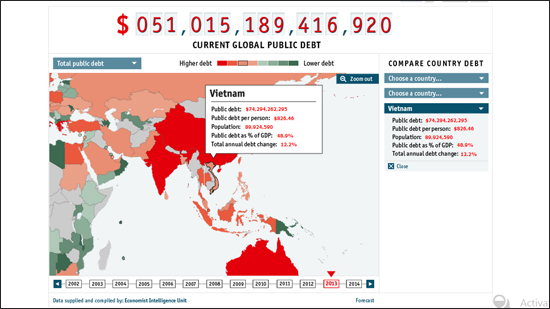|
Vietnam’s public debt may reach 95% of
GDP
If counting on
the state owned enterprises’ (SOEs) loans not guaranteed by the government,
the total public debt of

Every Vietnamese
citizen bears the public debt of $90.
How high is
The information can be found in the
report by the macroeconomic policy consultancy team belonging to the National
Assembly’s Economics Committee released on November 22, titled “Thach thuc
con o phia truoc” (challenges are still ahead).
The report showed that by the end of
2012,
However, if counting on the foreign
debts of enterprises, mostly SOEs, not guaranteed by the government, the
SOEs’ bank debts, the debts in bonds, the total public debt of
Under the Public Debt Law, the above
said debts are not counting on as the national public debts. However, the
fact that the government comes forward and guarantees for Vinashin to issue
$600 million worth of international rollover bonds and VND12 trillion worth
of bonds in Vietnam (Vinashion’s loans were not guaranteed in the past) shows
that experts have every reason to give the warning.
Government bond market valued roughly
$10 billion
While the public debt has been
increasing, the cash flow from credit institutions has been running within
the finance system when banks spend money on government bonds instead of
flowing out to the production sector.
The report has pointed out that the
cash flow that got stuck in the system has been used by commercial banks to
buy other valuable assets, such as government bonds or State Bank bonds.
Though the assets bring lower profits, but they are safer.
The primary government bond market’s
scale has been expanding rapidly. The total value of bonds issued and
guaranteed by the government in 2012 was roughly VND200 trillion, or $10
billion. The government issued bonds was VND115 trillion, equal to 85 percent
of that in 2011.
As a result, the capital flow has
been allocated in ineffective way. The capital has been flowing to the public
sector through the government bond issuance, instead of the private economic
sector through the lending to fund production.
This may bring high risks to the
public debts, lead to the dominance of the public investment over the private
investment and may lead to the ineffective allocation of resources. All
analysis works have pointed out that the quality and the productivity of the
private investment deals are far higher than that of public investments.
The state budget expenditure has been
increasing, which explains why the budget deficit in 2012 was still at 4.8
percent (it was 4.7 percent in 2011). The budget deficit ceiling has been
raised to 5.3 percent for 2013.
The report has cited the Asian
Development Bank (ADB) as saying that the Vietnamese bond market has been
growing fastest in the region, which also means the bigger debt payment duty
for
K. Chi,
|
Thứ Hai, 25 tháng 11, 2013
Đăng ký:
Đăng Nhận xét (Atom)
Không có nhận xét nào:
Đăng nhận xét